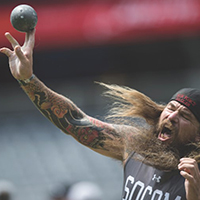Speed-power based training in the elderly and its potential for daily movement function enhancement

Accepted: 25 February 2020
HTML: 52
All claims expressed in this article are solely those of the authors and do not necessarily represent those of their affiliated organizations, or those of the publisher, the editors and the reviewers. Any product that may be evaluated in this article or claim that may be made by its manufacturer is not guaranteed or endorsed by the publisher.
Resistance exercise is widely recommended strategy to improve functional ability and quality of life of the elderly. Novel resistance exercises approaches, such as flywheel exercise have recently emerged as superior alternatives to traditional methods. Eccentic exercise methods are well documented to elicit different and often the more pronounced effect on physical ability and function of the elderly. By reviewing the relevant scientific literature, we found that only limited studies have investigated the effects of flywheel exercise in the elderly, however, the results are very promising. Thus, more research is desired to explore the effect of flywheel exercise type in elderly individuals.
Deschenes M. Effects of Aging on Muscle Fibre Type and Size. Sport Med. 2004;34: 809–824. DOI: https://doi.org/10.2165/00007256-200434120-00002
Sohn J, Kim S. Falls study: Proprioception, postural stability, and slips. Biomed Mater Eng. 2015;26: S693-703. DOI: https://doi.org/10.3233/BME-151361
Ribeiro F, Oliveira J. Aging effects on joint proprioception: the role of physical activity in proprioception preservation. Eur Rev Aging Phys Act. 2007;4: 71–76. DOI: https://doi.org/10.1007/s11556-007-0026-x
Zampieri S, Mosole S, Löfler S, Löfler S, Fruhmann H, Fruhmann H, et al. Physical exercise in Aging: Nine weeks of leg press or electrical stimulation training in 70 years old sedentary elderly people. Eur J Transl Myol. 2015;25: 237. doi:10.4081/ejtm.2015.5374 DOI: https://doi.org/10.4081/ejtm.2015.5374
Chodzko-Zajko WJ, Proctor DN, Fiatarone Singh MA, Minson CT, Nigg CR, Salem GJ, et al. Exercise and physical activity for older adults. Med Sci Sports Exerc. 2009;41: 1510–1530. doi:10.1249/MSS.0b013e3181a0c95c DOI: https://doi.org/10.1249/MSS.0b013e3181a0c95c
Häkkinen K. Ageing and Neuromuscular Adaptation to Strength Training. In: Komi P, editor. Strenght and power in sport The encyclopedia of sports medicine. Oxford: Blackwell scientific publishing; 2003. pp. 409–425. DOI: https://doi.org/10.1002/9780470757215.ch21
Ponce-Bravo H, Ponce C, Feriche B, Padial P. Influence of two different exercise programs on physical fitness and cognitive performance in active older adults: Functional resistance-band exercises vs. recreational oriented exercises. J Sport Sci Med. 2015;14: 716–722.
Byrne C, Faure C, Keene DJ, Lamb SE. Ageing, Muscle Power and Physical Function: A Systematic Review and Implications for Pragmatic Training Interventions. Sport Med. 2016;46: 1311–1332. doi:10.1007/s40279-016-0489-x DOI: https://doi.org/10.1007/s40279-016-0489-x
Ramírez-Campillo R, Castillo A, de la Fuente CI, Campos-Jara C, Andrade DC, Álvarez C, et al. High-speed resistance training is more effective than low-speed resistance training to increase functional capacity and muscle performance in older women. Exp Gerontol. 2014;58: 51–57. doi:10.1016/j.exger.2014.07.001 DOI: https://doi.org/10.1016/j.exger.2014.07.001
L. Sturnieks D, St George R, R. Lord S. Balance disorders in the elderly. Neurophysiol Clin. 2008;38: 467–478. doi:10.1016/j.neucli.2008.09.001 DOI: https://doi.org/10.1016/j.neucli.2008.09.001
Henwood TR, Riek S, Taaffe DR. Strength versus muscle power-specific resistance training in community-dwelling older adults. Journals Gerontol - Ser A Biol Sci Med Sci. 2008;63: 83–91. doi:10.1093/gerona/63.1.83 DOI: https://doi.org/10.1093/gerona/63.1.83
Onambélé GL, Maganaris CN, Mian OS, Tam E, Rejc E, McEwan IM, et al. Neuromuscular and balance responses to flywheel inertial versus weight training in older persons. J Biomech. 2008;41: 3133–3138. doi:10.1016/j.jbiomech.2008.09.004 DOI: https://doi.org/10.1016/j.jbiomech.2008.09.004
Bruseghini P, Calabria E, Tam E, Milanese C, Oliboni E, Pezzato A, et al. Effects of eight weeks of aerobic interval training and of isoinertial resistance training on risk factors of cardiometabolic diseases and exercise capacity in healthy elderly subjects. Oncotarget. 2015;6: 16998–17015. DOI: https://doi.org/10.18632/oncotarget.4031
Sañudo B, González-Navarrete Á, Álvarez-Barbosa F, de Hoyo M, Del Pozo J, Rogers ME. Effect of flywheel resistance training on balance performance in older adults. A randomized controlled trial. J Sport Sci Med. 2019;18: 344–350.
Reeves ND, Maganaris CN, Longo S, Narici M V. Differential adaptations to eccentric versus conventional resistance training in older humans. Exp Physiol. 2009;94: 825–833. doi:10.1113/expphysiol.2009.046599 DOI: https://doi.org/10.1113/expphysiol.2009.046599
Zaleski AL, Taylor BA, Panza GA, Wu Y, Pescatello LS, Thompson PD, et al. Coming of age: considerations in the prescription of exercise for older adults. Methodist Debakey Cardiovasc J. 2016;12: 98–104. DOI: https://doi.org/10.14797/mdcj-12-2-98
Clark DJ, Patten C. Eccentric versus concentric resistance training to enhance neuromuscular activation and walking speed following stroke. Neurorehabil Neural Repair. 2013;27: 335–344. doi:10.1177/1545968312469833 DOI: https://doi.org/10.1177/1545968312469833
Sarabon N, Löfler S, Hosszu G, Hofer C. Mobility test protocols for the elderly: a methodological note. Eur J Transl Myol. 2015;25: 253. doi:10.4081/ejtm.2015.5385 DOI: https://doi.org/10.4081/ejtm.2015.5385
Gianoudis J, Bailey C, Ebling P, Nowson C, Sanders K, Hill K, et al. Effects of a targeted multimodal exercise program incorporating high-speed power training on falls and fracture risk factors in older adults: a community-based randomized controlled trial. J Bone Min Res. 2014;29. DOI: https://doi.org/10.1002/jbmr.2014
PAGEPress has chosen to apply the Creative Commons Attribution NonCommercial 4.0 International License (CC BY-NC 4.0) to all manuscripts to be published.


 https://doi.org/10.4081/ejtm.2019.8898
https://doi.org/10.4081/ejtm.2019.8898



